[Click on highlighted links for videos and more information.]
In the 70s we had Opal’s Silver Spoon Café on the Lily Tomlin show and Mel’s Diner in ALICE. Today these have morphed into the Food Network. A pinch and a shake are no longer the norm. Recipes are formulaic, portions exact. Professional chefs have replaced housewives at the local diner. Plates that used to be simple and wholesome food have iterated into extravagant works of art. When I go out today, I’m reminded of what Dali said about Mexico, that he would not return to a country that was more surreal than his own paintings.
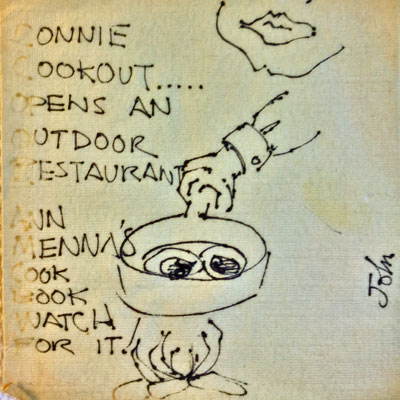
Sea Gull Cellar Bar Napkin Art, John the artist
I remember the days of Home Cooking from my time at the Sea Gull Restaurant in Mendocino during the 70s and 80s although they are quickly becoming distant memories.
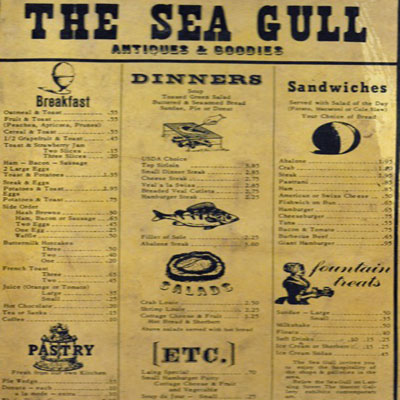
Contractors, bus drivers, mechanics, shop clerks, school teachers, professionals, deliverymen, writers, artists, musicians and vagabonds—they all socialized in the Sea Gull Coffee Shop. It wasn’t Mel’s Diner from ALICE, but there were similarities. Mary Lou served her popular luncheon specials (chicken parmesan, clam sandwich, spaghetti and meatballs, beef stroganoff, different every day). Black Joyce (Joyce Lesesne), the only black employee, waited on the Hells Angels because no one else would. She was beautiful and funny and knew exactly how to turn them into blubbering adolescents. Joyce lived in a spare room with my wife and me in the house next door to the Sea Gull and we marveled at her many creative wigs and ability to change the way she looked on a whim. And then there were the locals, they thought they owned the place and in some ways they did.
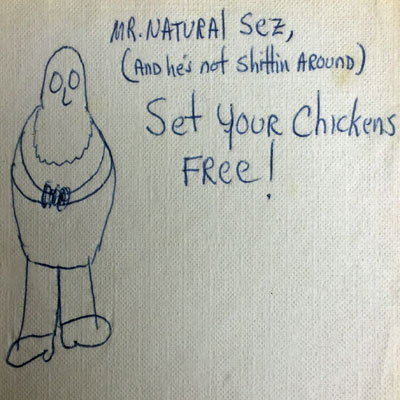
Sea Gull Cellar Bar Napkin Art, artist unknown
They came alone or in groups, Don, Skip, Ken, Big John, Big Al, Jake, B-Not, Wayne Combash, Rex and Char, Jacques Helfer, Bird Baker, Crow, Larry Fuente, Eric the Gardener, Merlin Tinker, Martin Schmidt, Clifford, Dora, Ina, Marie, Jerry and Steven Huckaba, Lenny Laks, Laing Chambers, Jerry McIntyre, Bobbie Markels, Dennis Heckala, Tom Bong, Kelley, Peggy and her wild son Dillon—these and so many more served by everyone’s favorite waitress Debbie Simpson.
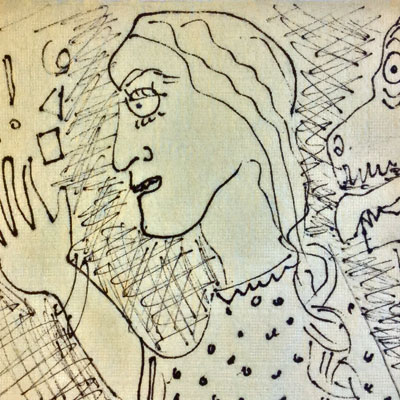
Sea Gull Cellar Bar Napkin Art, artist unknown
As the new kid on the block, I learned to expect the unexpected. One night in the middle of dinner the cook, Linda Alexander, left the kitchen to run across the street to her apartment where her dog was delivering puppies. The waitresses kept the customers happy and even managed to cook a few orders. In those days when the fare was truly Home Cooking, waitresses could juggle the jobs of cooking and serving at the same time. The cook (we did not call them chefs then) returned to the kitchen after helping to deliver a healthy litter, washed her hands, and went to work.
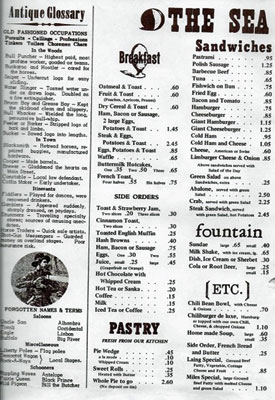
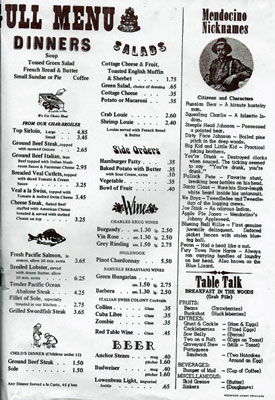
The first cooks at the Sea Gull were housewives looking for a little extra income. They made up the menu as they went along. Dinner potatoes were the morning hash browns cut into triangles with melted cheese on top. Breakfast and lunch were served all day. Wonder Bread was used to make the toast. The fruit (Peaches, Apricots, Prunes) for the Fruit & Toast was packed in sweet syrup and came from a #10 can. Dinner selections widened slowly with the business. The original menu was heavy on Ground Beef: Ground Beef Steak, Ground Beef Italian. Specials were added like Breaded Veal Cutlets, Veal a la Swiss, and Cheese Steak. The local fish (Salmon, Sole, Snapper) was always served fresh, lobster and swordfish frozen.
The usual sandwiches were on the lunch menu with a few oddballs like Fishwich on a Bun, Limburger Cheese & Onion, and a Fried Egg sandwich. Coffee and Sanka were offered, Soft Drinks, Ice Cream Sodas, and Floats. For drinkers, a limited selection of wines from Charles Krug, Sebastiani, and Inglenook was available together with Italian Swiss Colony cocktails. Anchor Steam on tap was a specialty delivered direct from the brewery in San Francisco on the Grayhound bus. For a time, the Sea Gull was the only place where Anchor Steam draft was served outside the City.
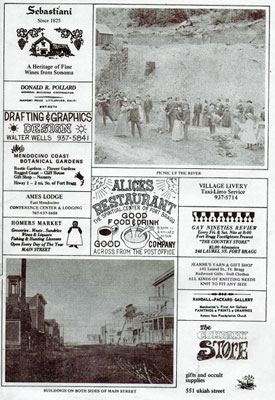
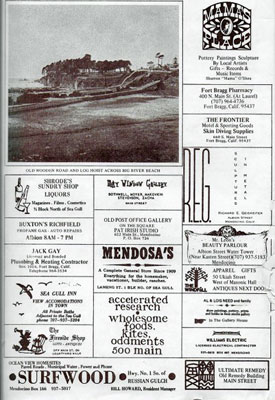
Special requests included Dead Man’s Stew (unbuttered toast with warm milk known elsewhere as Milk Toast), margarine for hotcakes for those on a heart-healthy diet, horseradish grown, cooked, mashed and prepared by the owner, and erratically timed boiled eggs that were always a surprise. Some items known only to locals like the Laing Special (Ground Beef Patty, Vegetable, Cottage Cheese & Fruit) and the Miles Special (large Ground Beef Patty with melted Cheese and green Salad) were eventually placed on the printed menu.
The first menus were glued onto tempered hardboard. Later they were printed on thin paper in newspaper format with advertisements, historical pictures, with local sayings that humored the tourists. Ultimately the menu was standardized on sturdy beige rectangular stock. Over time the menu items changed, the cooks became chefs. Some, like kitchen manager Steve Scudder, left to study at a professional chef school.
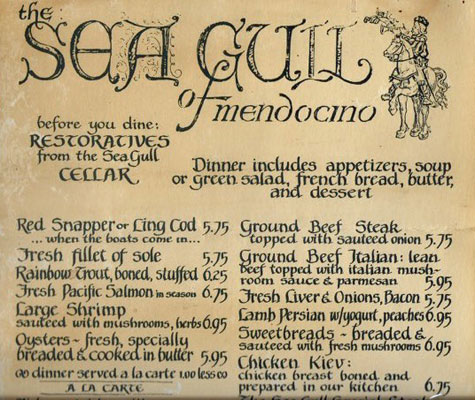
The Yogi Bowl invented by chef Gary Lyte (brown rice topped with sautéed vegetables) became a popular item for the hip crowd while the German scramble (eggs scrambled with sausage, bacon, cheese, onions, peppers, and potatoes) was popular for those with large appetites. A Pacific scramble using salmon in place of meat and a vegetarian version were also offered. Fancier wines appeared with each new wine list. The days passed when the “cooks” put a red rubber ball into Big John’s salad as a joke. Dinner began to feature Chicken Kiev, Sweetbreads, Calamari, Lamb Persian, Rainbow Trout stuffed with shrimp, Bouillabaise, and Veal Oscar.
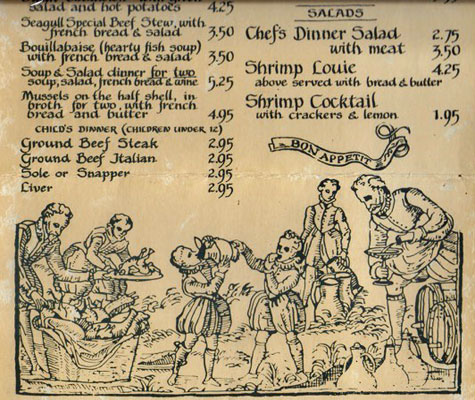
The most popular items were the steak sandwich, the fish sandwich, the homemade pies, the daily luncheon specials and, of course, the Cheeseburgers and Giant Cheeseburgers. The burgers were served with a green salad, not French fries. A deep fryer at the Sea Gull? Horrors!

Sea Gull Cellar Bar Napkin Art, Roy Hoggard artist
The service was never pretentious. Once in the early sixties during the dead of winter the Secretary of State for California made a reservation. His was the only reservation and he was the only customer for the night. The original owners, Martin and Marlene, were in the kitchen and they were anxious to make a good impression on such an important guest. They pulled the waitress, Barbara, aside and told her to be sure to give the Secretary excellent service. He arrived in a flurry wearing a black cape. He sat at one of the tables in the Coffee Shop (the dining room had not yet been built onto the original building). Barbara approached him with a smile and stood to take his order. After perusing the menu, he told her what he wished to eat. She then yelled succinctly and crudely into the kitchen: ““T-Bone just hit the grill.” This was certainly not up to the gourmet standards anticipated by the embarrassed owners. It was not the atmosphere they were hoping to project but the Secretary was pleased with his dinner and seemed to enjoy the entire experience.
Change is inevitable. The Sea Gull did change over time. The most radical change, after the 1976 fire, was the moving of the Cellar Bar upstairs. The room was larger and live music, a rarity in the downstairs bar, became practical and popular. The new restaurant was laid out on essentially the same floor plan but the kitchen, originally a hodge-podge of freezers and refrigerators on various levels of plywood floors patched together with odd scraps of linoleum in different colors purchased on sale at Mendosas. I don’t think the Home Cooking atmosphere was ever sacrificed. I hope not.
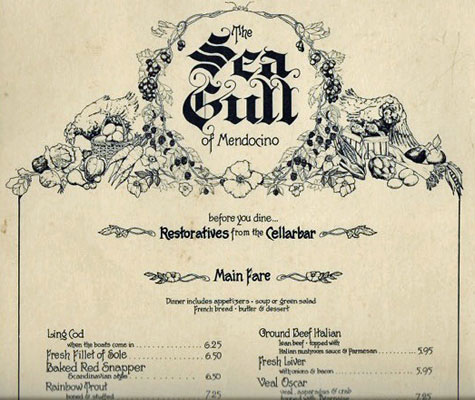
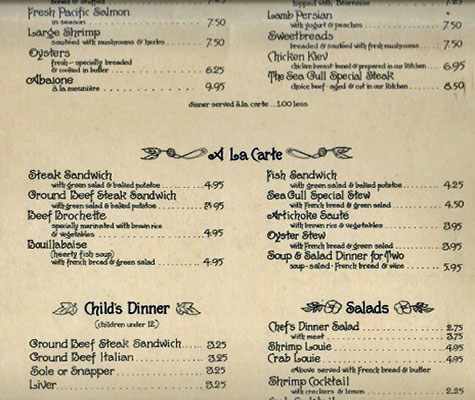
Once, I had a chance to make my personal mark on the kitchen. A customer came in who insisted his steak was to be “burned on the outside and raw on the inside.” The cook (chef) was not sure how to accommodate this peculiar request. I was summoned to the kitchen to see if I could reason with the guest. The man was insistent on having his steak “cooked the way he liked it.” I went into the freezer and pulled out a frozen strip of rib eye steak. I pulled the meat saw off the wall and sawed off an inch thick steak from the frozen strip. I put it on the broiler and cooked it on the first side at high heat until it was burned (slightly), turned it over and did the same to the other side. As I hoped, it remained raw on the inside. The customer not only ate it, he raved on the way out of the restaurant that it was the “best steak he’d ever had.” It was probably my good luck, but I suspect that my mother and grandmother taught me a little about Home Cooking when I was young. My father, divorced from my mother, owned a hotel and restaurant in the Sierras called Nyack Lodge. I’m sure I learned a little there too, but that’s another story.

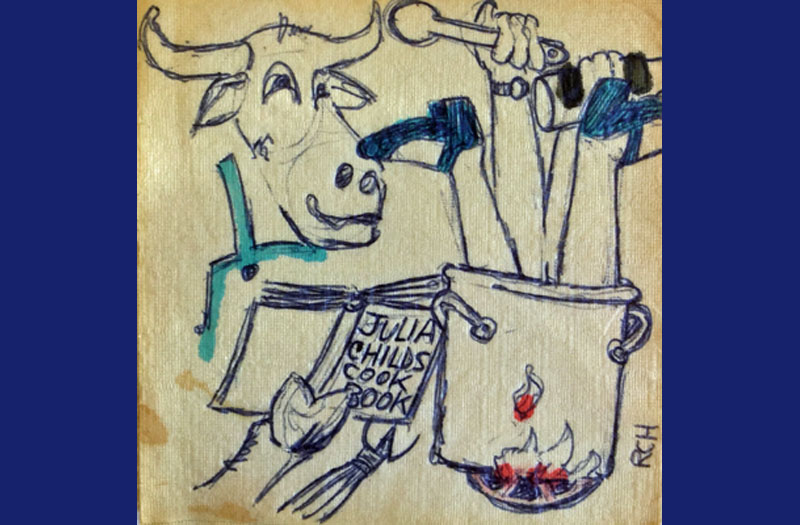
And after enjoying yet another yogi bowl, there were a variety of appointments in the branch office of the DA downstairs.
Thanks for the memories of Jacque, Crow, Black Joyce, and even Wayne, who sometimes relied on Lewis Webb to get him home.
Damn, David–the old menus are making me drool. And the prices!!!!
I was one of the onlookers on the morning of the Cellar Bar fire in ’76. How did I happen to be up so early? I lived next door to the Beaujolais, had a job at the sea urchin processing plant in Noyo, and so was up and dressed at dawn when the sirens summoned me down the street. Watched the flames roar and devour the building. The word was that a cigarette had smoldered in the upholstery of one of the overstuffed chairs in the bar, then FOOMP! I sure did love that Cellar Bar, flammable though it was, with those comfy chairs and sofas. Too good to last.
My career as a sea-urchin processor lasted three days. It was cold, wretched, soaking wet, the pay was lousy, but mainly, it was deeply disgusting. Took a tuna sandwich to work one of those days, intending to eat it for lunch, but found it about as appetizing as leftover haggis. One whiff and I almost upchucked. Could not eat tuna, nor anything remotely fishy, for years after. When I learned that the Japanese paid something like $40 a pound for that slimy, gooey, revolting yellow urchin roe, I almost upchucked again.
Thanks for those comments straight from your heart, or should I say gut? Yea, those prices! If I had just charged an arm and a leg more, heck, I could aftord Viagra today not to mention designer mezcal.
David-as you and Nicholas Wilson are the documentarians of our collective history, I thought you’d like the correct spelling of a couple of names. I humbly offer Joyce Lesesne, and Jerry and Steven Huckaba.
Thank you very much! Changes made. I depend on old friends to refresh, improve, and correct my old mind. Great to hear from you.